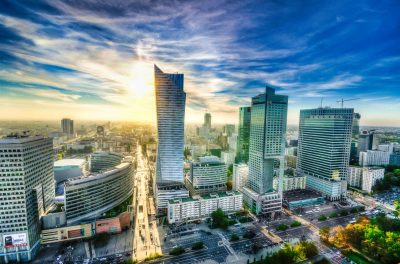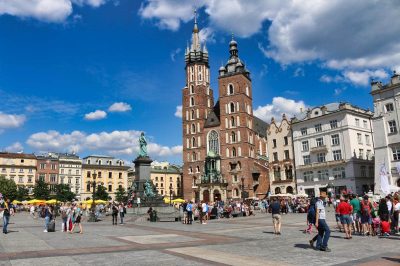Wrocław is turning from a hidden secret to a real classic for Poland city trips. Many Wroclaw sights are unique and can easily fill a whole weekend. Wroclaw does not have to take a back seat to the other Polish metropolises Warsaw, Krakow or Gdansk. Wroclaw was even the European Capital of Culture in 2016 and is only about 4 hours away from Berlin by train and can be reached from many other European destinations by plane or train. Reason enough to introduce you to the best Wroclaw sights.
Wroclaw Old Town Sights
In the Old Town of Wroclaw alone there are so many sights and architectural monuments that you could fill half a dozen other cities with them. The Old Town is still the best place to spend time.
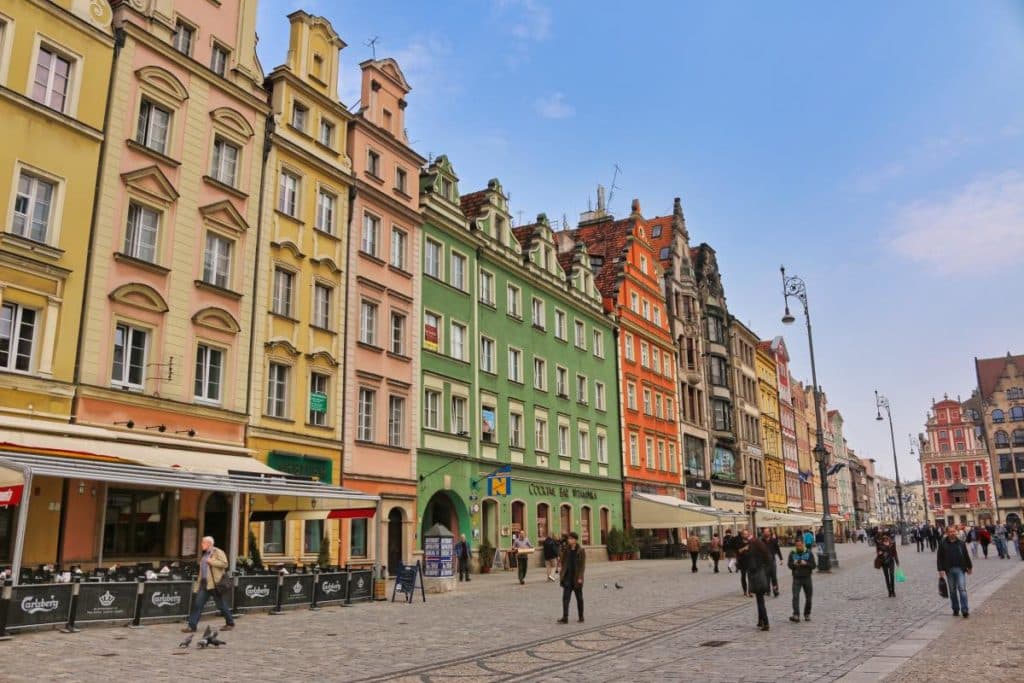
Rynek – Wroclaw Ring
At 212 by 175 meters, Wroclaw’s Ring is one of the largest market squares in Poland. Countless beautiful buildings here attract the attention of viewers. Of particular interest are the houses Hansel and Gretel, the building To the Golden Dog, House To the Golden Anchor (Rynek 52), House To the Griffin (Rynek 2), House To the Seven Electors (Rynek 8) and the monument to Alexander Fredro, which originally stood in Lviv.
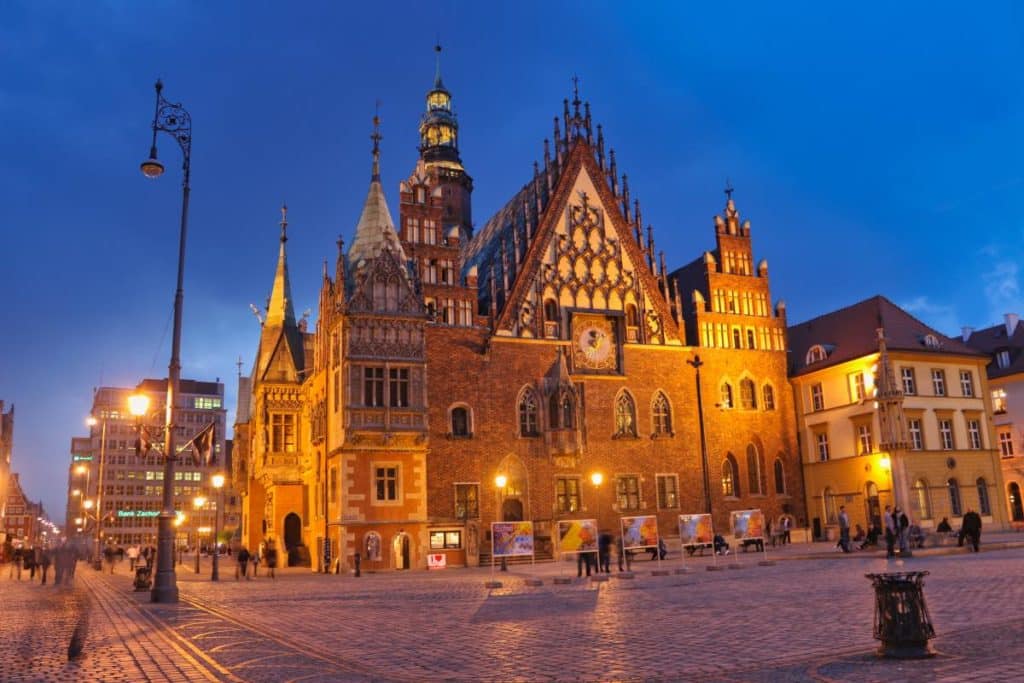
Town hall
The City Hall is one of the icons of the city of Wroclaw and of course it is also located on the Rynek Square. It is one of the most beautiful gothic buildings in Europe and definitely belongs on your sightseeing plan for Wroclaw. Well Gothic it is to a large extent. The 66 meter high city hall tower is a testimony of the Renaissance, but still fits well into the ensemble, as does the astronomical clock on the east side.
In the cellar of the town hall there is also the Piwnica Świdnicka. It is considered to be the oldest restaurant in the whole of Poland and has been operating almost without interruption since 1273. However, it is currently closed. The city wants to have the rooms renovated. The renovation is expected to cost more than one million Euro though. In the town hall itself there is the exhibition of the Museum of Bourgeois Art. It is not stunning, but you will get to see the interiors of the town hall and that makes the visit pay off.
Pillory
The pillory, where people have been paraded since the year Columbus is said to have discovered America (1492), is once again located right next to the town hall. For Wroclaw, the pillory was a sign of pride, as it showed that the city was governed by law and order. Until the In the 18th century, people were still executed there and The 19th century was pilloried. Severely destroyed in the Second World War and demolished in 1947, the pillory was rebuilt in 1985. Today, it is the most popular meeting place in the city and anyone meeting in Wroclaw should ideally do so here.
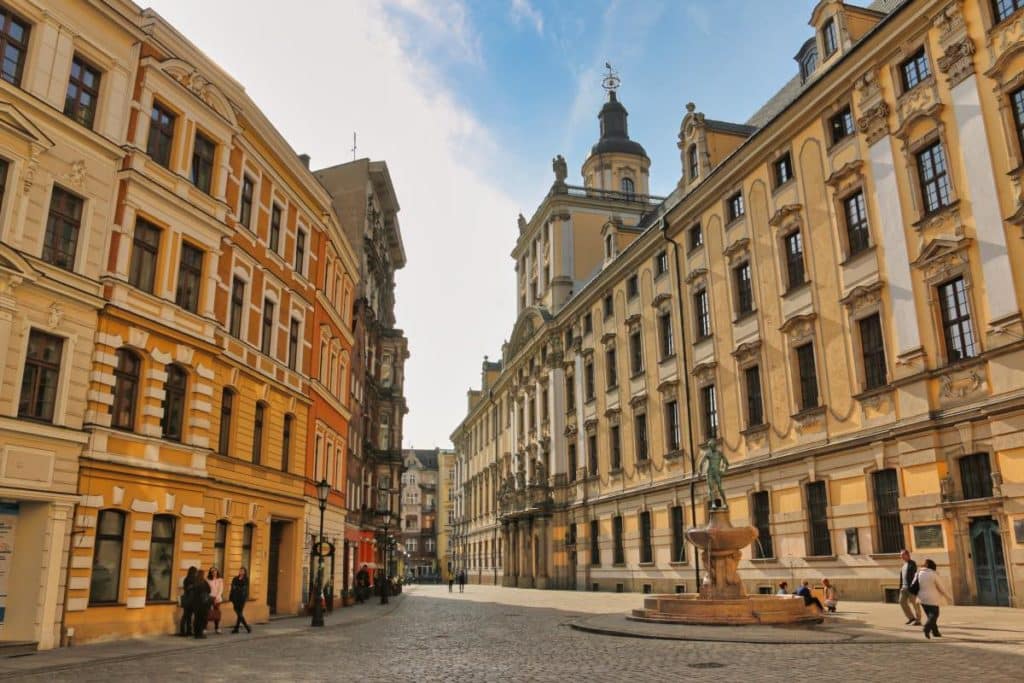
University and University Museum
The University of Wrocław was once founded as a school for Jesuits in the 17th century. Secularized by the Prussian authorities in 1811, it quickly developed into a center of education. Especially in the 20th century it was home to some famous scientists. Among them there have been 9 Nobel Prize winners so far. The main building is open to tourists who can enjoy the amazing baroque interiors, which date back to the time when the Jesuits were in charge. Pay full admission for all 4 halls and enjoy the Aula Leopoldina, which still looks more like a church than a university hall. Then climb the Mathematical Tower and take in the view over the Odra River and parts of the Old Town.
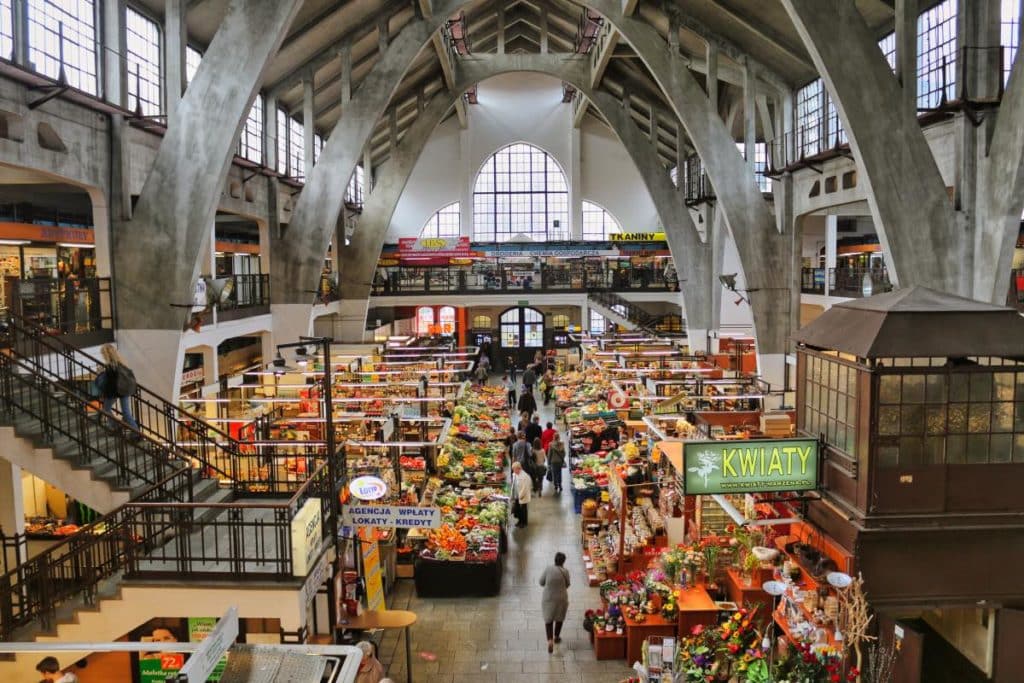
Wroclaw Market Hall
It is rare to see real market halls that are still used as such. For this reason alone, the Wroclaw Market Hall is one of the Wroclaw sights you should not miss. It was also here where the famous serial killer Karl Denke, who probably killed far more than 40 people, sold body parts in pickle jars. But don’t worry, that was about 100 years ago and Denke hanged himself in his cell. So you can safely try some of the regional specialties that are available here.
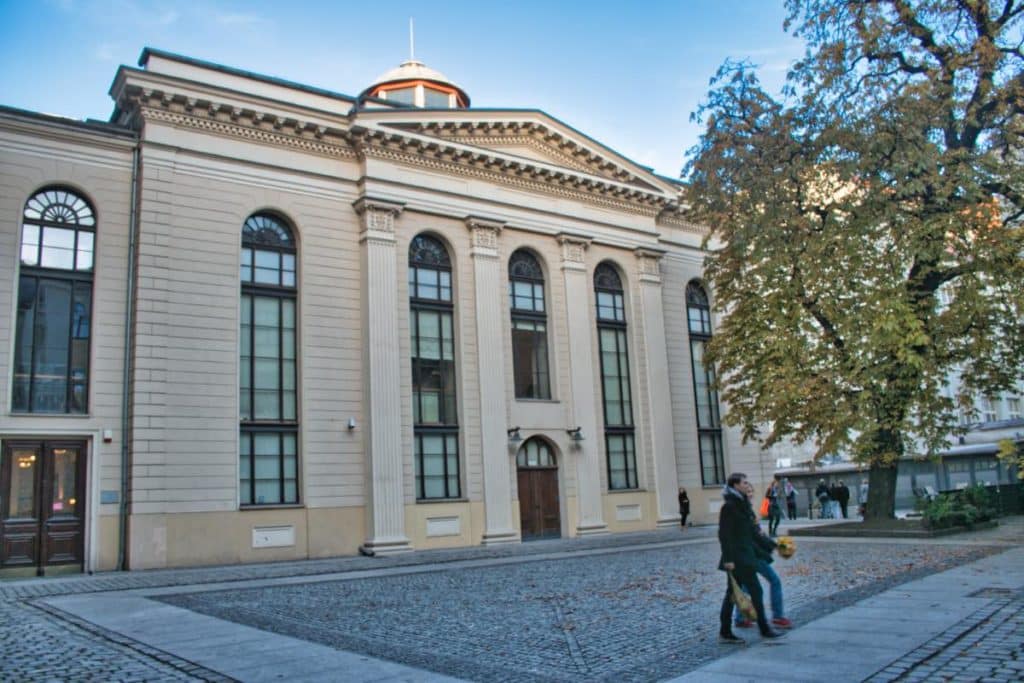
White Stork Synagoge
The White Stork Synagogue was built in 1829 and is named after an inn that stood here in the same place before. Due to its location in a backyard and the proximity to the surrounding buildings, the synagogue was spared from destruction by the Nazis. Nevertheless, Jews were deported from here to the death camps. After the war, the synagogue fell into disrepair and was returned to the Jewish community only in 1996. Today, prayers are held here, but there is also an exhibition on the history of the Jews in Silesia.
Sights on Ostrów Tumski
If you thought that the Old Town is the absolute highlight of Wroclaw, you clearly haven’t been to Ostrów Tumski – Cathedral Island. This is not only where the city was founded. The small streets and the impressive cathedral are the best motifs for photos. It is worthwhile first of all to look from the old town side over the Odra to the Cathedral Island. This way you can see the whole beauty of the place. You will probably get to the island via the Cathedral Bridge, which decorated with thousands of love locks that people left there. On the island itself, most of the buildings are in the hands of the archbishopric.
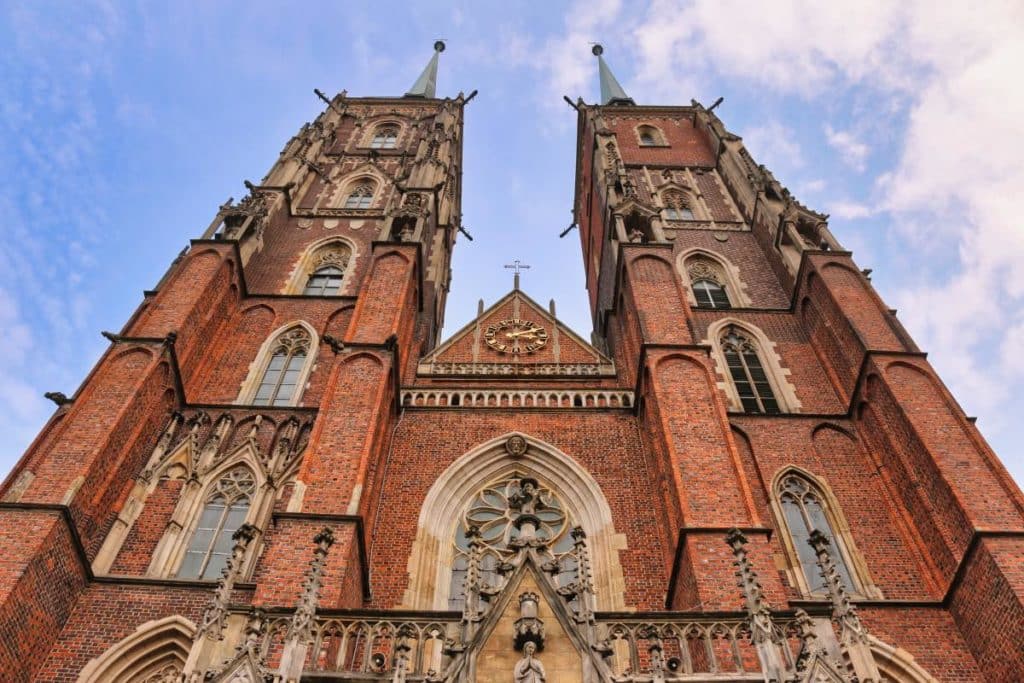
Cathedral St. John the Baptist
The cathedral, which was started in the 13th century, is one of the most beautiful churches in Poland. It is famous not only for its beautiful stained glass windows, but also for the great view (read more under Viewpoints). Also the organ once was among the largest in the world.
Botanical Garden
The Wroclaw Botanical Garden, which is also located on Cathedral Island, is often overlooked. It was established under the Prussians as part of the university and is one of the city’s real insider tips. Hundreds of plants can be seen here. Picturesque bridges provide beautiful photo motifs.
Best panoramic view of Wrocław
Wrocław is a city of towers. No less than four of the famous Wrocław landmarks offer the opportunity to enjoy the view of Wrocław from above. And the viewing platforms are all very different too!
Skytower Wrocław
Anyone who thinks that Poland’s highest viewing terrace is in Warsaw is mistaken. Poland’s tallest building is the Palace of Culture in Warsaw , but the Skytower Wrocław has the highest viewing terrace at 212 meters. And the best thing about it: you can take the elevator to the top and enjoy the view.
Skytower Wrocław Infos
Address: Powstańców Śląskich 95Opening hours: Tours from Monday to Friday always on the hour and half hour between 9am and 8.30pm. At weekends you can take the elevator up until 9.30 pm. Tickets cost 11 zloty during the week, reduced 6 zloty (around 2.50 or 1.50 euros) and 16 or reduced 8 zloty (4 euros or 2 euros) at the weekend. The discount also applies to students with ID.
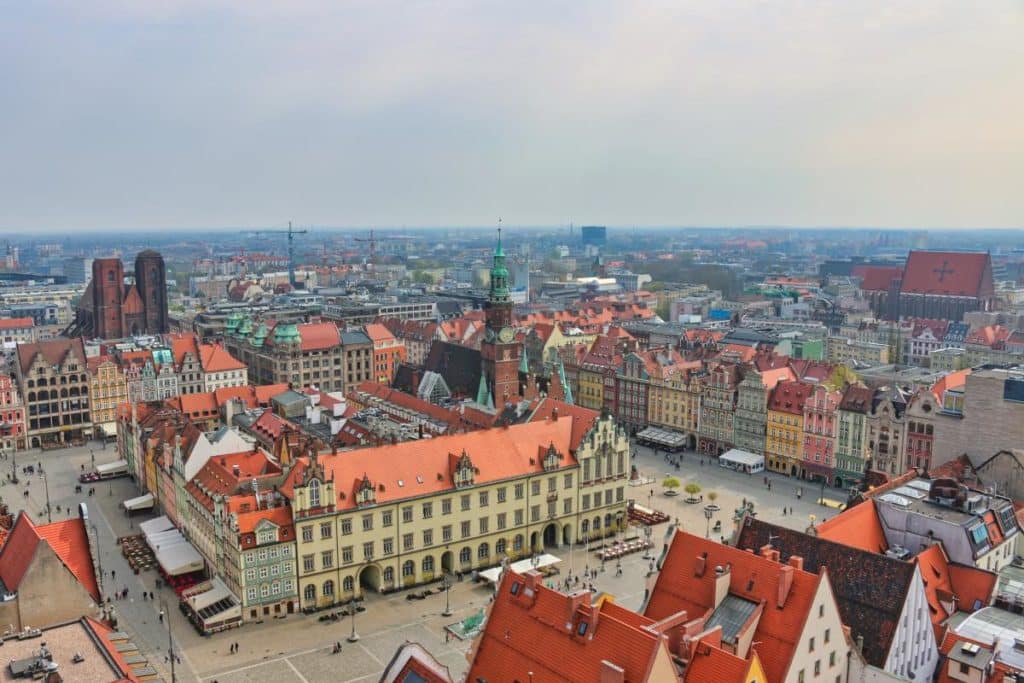
Tower of St. Elizabeth
Instead, I enjoyed the view from the tower of St. Elisabeth’s Church in Wroclaw. The view from St. Elisabeth is better because the church is very close to the market. From there you can also see the entire old town. This also compensates for the fitness program you have to complete. You have to climb more than 300 steps in the narrow tower corridor. That was really exhausting, especially as I hadn’t eaten anything yet. Once back downstairs, you should definitely visit the brick church.
Info about the tower of St. Elizabeth’s Church
Address: św. Elżbiety 1/2
Opening hours: From 9 a.m. to 6 p.m., anyone can enter for 5 zlotys (around 1.25 euros upwards). Provided you are fit 🙂 The church is not accessible to tourists during services.
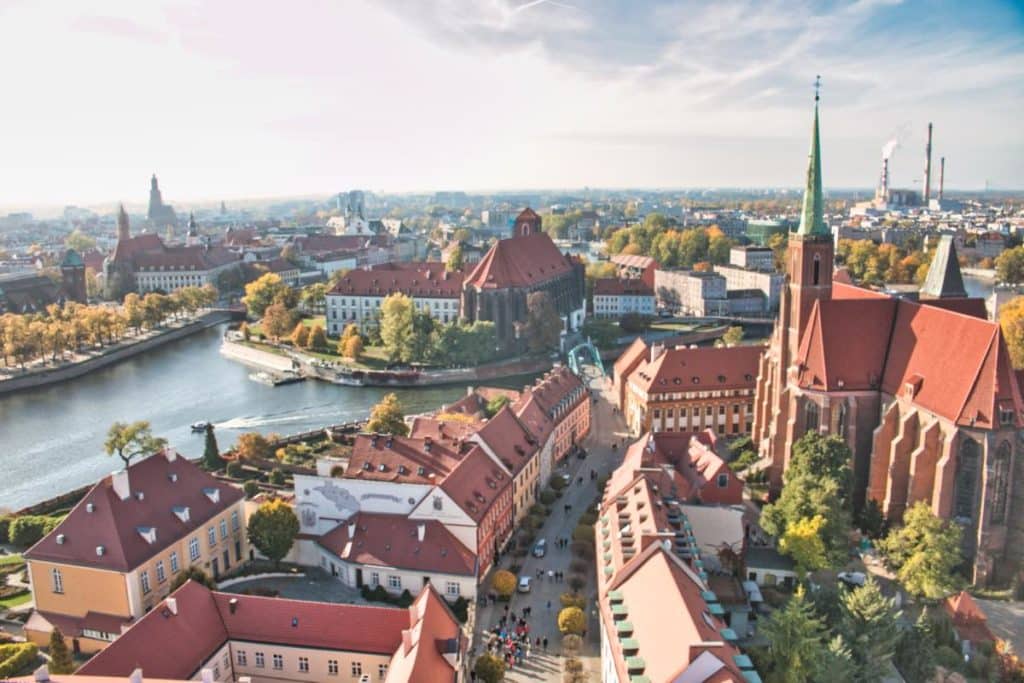
Wroclaw Cathedral Tower
In addition to the Elisabeth Church just described, the cathedral is also a really great building. The whole of Ostrow Tumski is well worth seeing. Almost all of the city’s churches are made of red brick. This is actually my favorite building material for old buildings. The color red can be found everywhere in the brickwork on the buildings of the old Wroclaw fortress.
Info about the tower of the cathedral
Address: plac Katedralny
Opening hours: From 10 a.m. to 5.30 p.m. you can enter the cathedral for 4 zloty (reduced rate 2) and take the elevator up to the tower for 5 zloty (reduced rate 4). Therefore, no fitness is required here either. However, a head for heights is recommended. The church is not accessible to tourists during Sunday services. and only opens at 2 pm.
Bridge of penitents
Another interesting panorama point is the Bridge of the Penitents, which connects the two towers of St. Magdalene. Here you also have a fantastic view over the city at a height of 45 meters.
Infos on the Bridge of Penitents
Address: Szewska 10
Opening hours: From 10 a.m. to 6 p.m. you can visit the bridge for 8 zloty (reduced rate 5).
Wrocław Sightseeing Art -Without end Art in Wrocław
Wroclaw was rightly the European Capital of Culture 2016. There is not only an art academy in the city. In many places of the city there are works of art to see. Sculptures are waiting for you almost everywhere. Galleries offer interesting modern art and also older works of art entice you to visit.
Wroclaw Gnomes
They are in all sorts of places and seem to be following you around. And indeed, they were once also a political symbol. In the 1980s, the artist Major Waldemar Fydrych painted the Wroclaw gnomes everywhere in protest against the communist regime. Initially, a memorial with the name Papa Krasnal was erected in 2005 to commemorate this. The city then commissioned another artist to erect 5 dwarfs. This is where the hype began and there are now over 400 dwarves in the city. The city of Wrocław has even given gnomes as gifts to the twin cities. Many tourists literally go hunting for the dwarves*– a great activity with children, by the way.
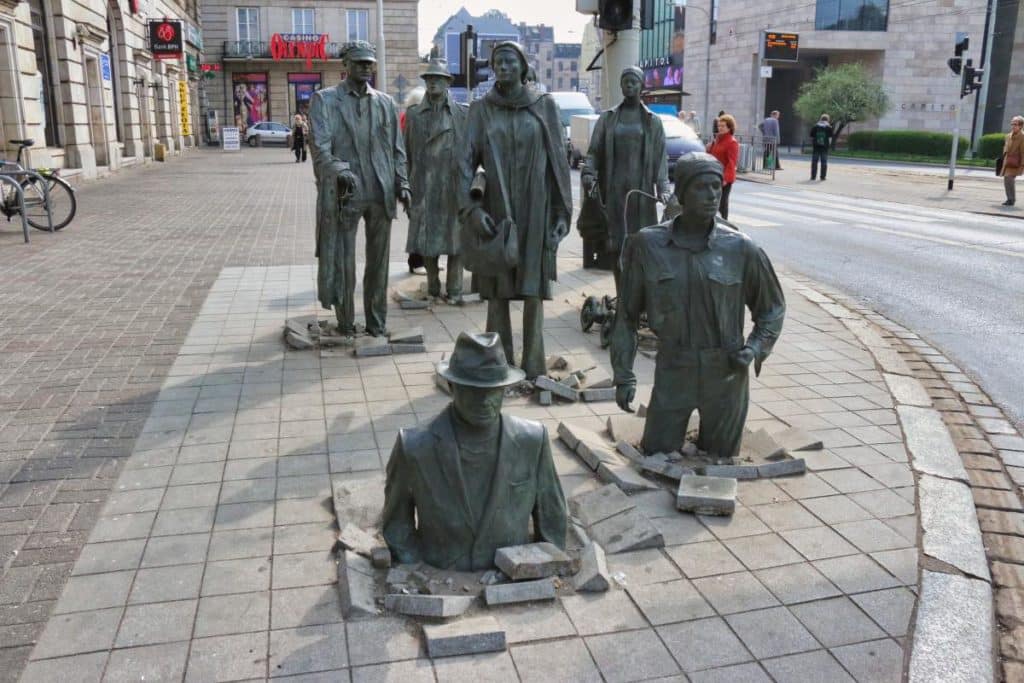
The Passage
An impressive monument is the artwork Passage, also called the Monument to the Anonymous Passers-by. The work by Jerzy Kalina commemorates the victims of communist terror who disappeared during the period of martial law in communist Poland in the 1980s. The figures sink on one side of a traffic light intersection into the ground, while on the other side seven figure reappear.
Street Art in Wrocław
The street art in Wrocław is hard to miss. Many walls are covered with oversized graffiti. Sculptures and works of art can be found everywhere on the streets. There is a lively gallery scene, which, among other things, organize a joint gallery evening in Wrocław every year. You can also take a walk to explore the lively art scene in the neighborhood between the Old Town and Nadodrze train station.
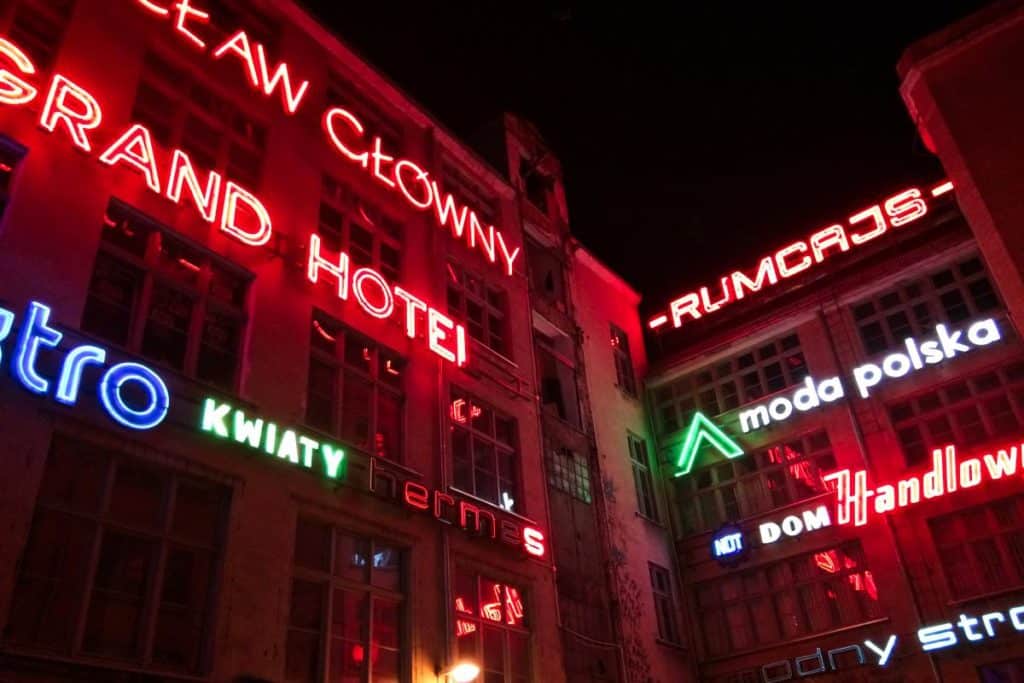
Neonside Gallery
Neon Side Gallery (Galeria Neonów) is a collection of neon signs hung together in a backyard. This used to be the location of the Reklama company, which produced neon signs. The owner of the gallery, Tomasz Kosmalski, wanted to save the advertisements and therefore bought more and more of them. Today there are more than 30 advertisements that delight visitors.
Racławice Panorama
The panorama was originally created in 1894 to mark the 100th anniversary of the founding of the city. It was inaugurated on the 50th anniversary of the victory of the Polish army led by General Tadeusz Kościuszko over the Russian army in the Battle of Racławice in Lviv (now Ukraine). When the Poles were expelled from eastern Galicia, the panorama was dismantled and stored away. As the Polish communists did not want to anger the Soviets, they hid the panorama until it was shown again in the 1980s in a specially constructed building. The painting measures 15 by 114 meters, making it one of the largest paintings in the world.
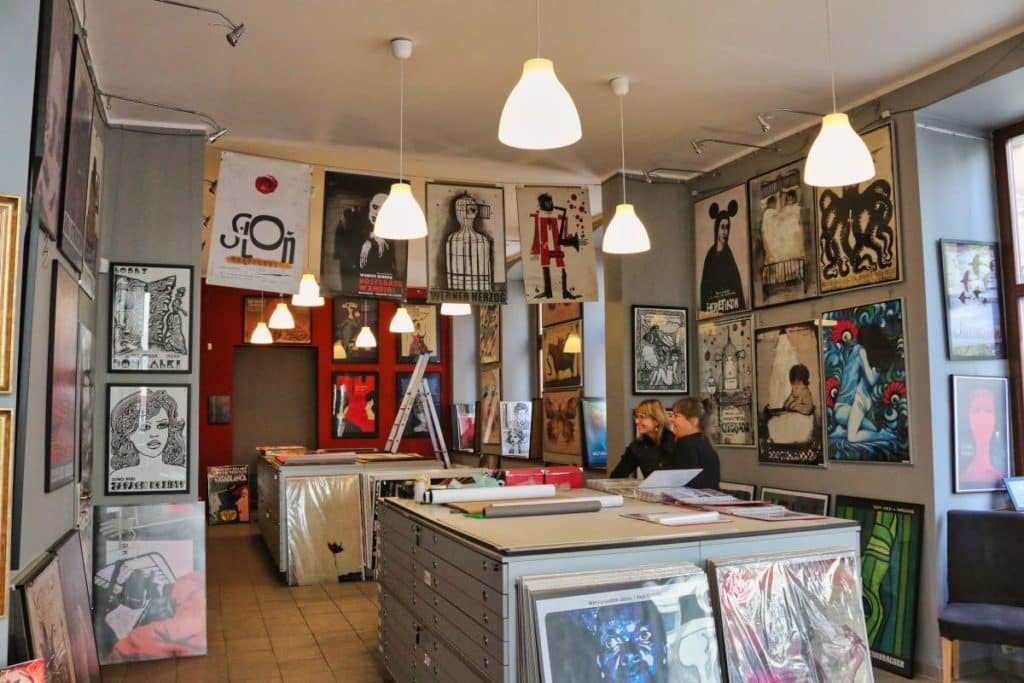
Polish Poster Gallery Wroclaw
You should end your tour of the galleries in Wrocław at the Polish Poster Gallery. There you can find, among other things, many alternative movie posters and other things from the advertising history of communist Poland. A virtually unknown fact is that since film posters for films from the West were not allowed during the communist era, each of the Eastern bloc countries had its own posters. Gallery owner Krzysztof Marcinkiewicz exhibits the best posters here and has a catalog with 5000 additional motifs. If you don’t know where else to find galleries, you can get some helpful tips here. But then you have to carry the posters with you all the time, because there is no way you are gonna leave here without one 🙂
Address: Polish Poster Gallery, ul. Św. Mikołaja 54/55, open daily from 12 to 6 pm. In addition to posters, there are also postcards and many interesting stories about Polish poster art.
Steel sculpture NAWA on Wsypa Daliowa Island
Admirers will find an unusual work of art on the island of Wyspa Daliowa. The large sculpture NAWA by designer Oskar Zięta from Wroclaw is almost 7 meters high and 15 meters wide and reflects the surroundings. The glossy stainless steel project was erected for the celebration of the European Capital of Culture 2016 entitled “Metamorphosis of Culture”.
Architectural Wrocław sights – The most beautiful buildings of Wrocław
Wroclaw used to be called Breslau, it was Polish, then Austrian, Prussian, German, occupied by the Soviets and now it’s Polish, but still often feels Silesian. A pretty good base not only for tasty food, but also for different architectural styles. To be fair, though, the Austrians and Germans have left the most traces.
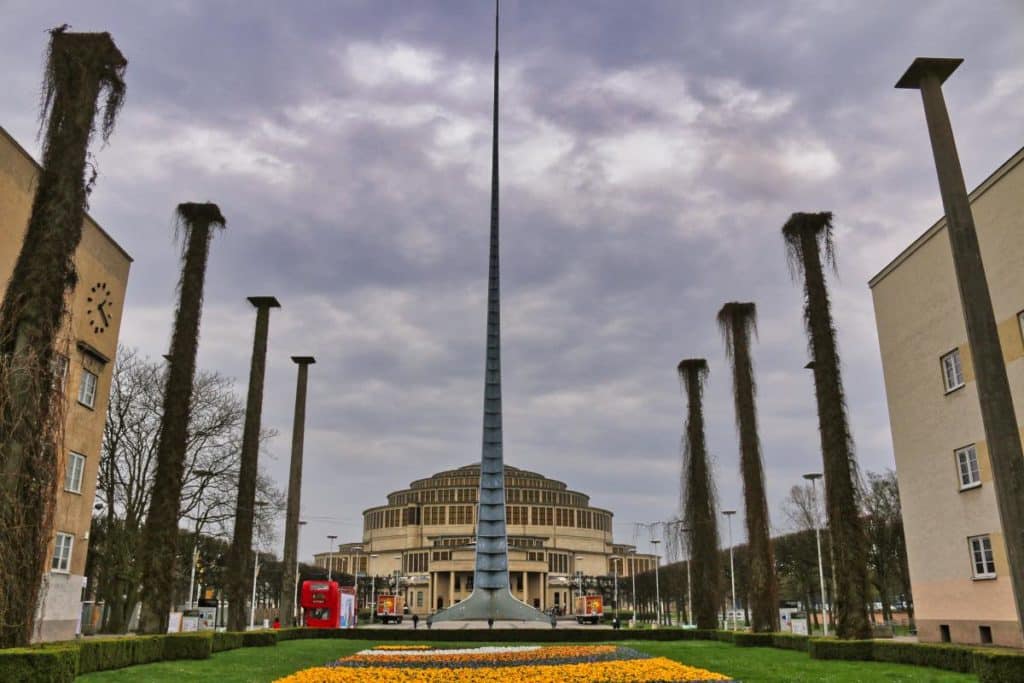
Wroclaw Centennial Hall – Unique UNESCO World Heritage Site
Even though many admire the city’s churches, some visitors don’t necessarily realize that there are other buildings in Wrocław that are also very different in style. The Jahrhunderthalle in particular, which is now a World Heritage Site, is an outstanding example of German architecture from before the First World War. It was built between 1911 and 1913 by the Wroclaw city architect Max Berg. Personally, it reminds me a little of the Blue Mosque in Istanbul. But it is actually an event and exhibition hall. It can be visited today. However, we recommend that you combine your visit to the Jahrhunderthalle with a guided tour so that you can learn more about this fascinating World Heritage Site.
Iglica
The needle-shaped monument was erected in Wrocław in 1948 on the occasion of an exhibition about the “regained Western territories”. At that time still over 100 meters high, parts of the sculpture fell victim to a storm. Today, the needle is therefore only 90 meters high, but has just been renovated and is one of the city’s landmarks.
Multimedia fountain
In front of the hall there is also a large water basin. In the basin there are many fountains, which create a magnificent fountain system, which is illuminated in many different colors and is a popular tourist attraction in Wroclaw.
Most Grunwaldzki
Grunwald Bridge is one of the longest suspension bridges in Poland. Originally it was opened as the Emperor’s Bridge and Wilhelm II, the German emperor, was present in person. It was damaged during World War II but then repaired and reopened by 1947 – now as Most Grunwaldzki in memory of the Battle of Tannenberg.
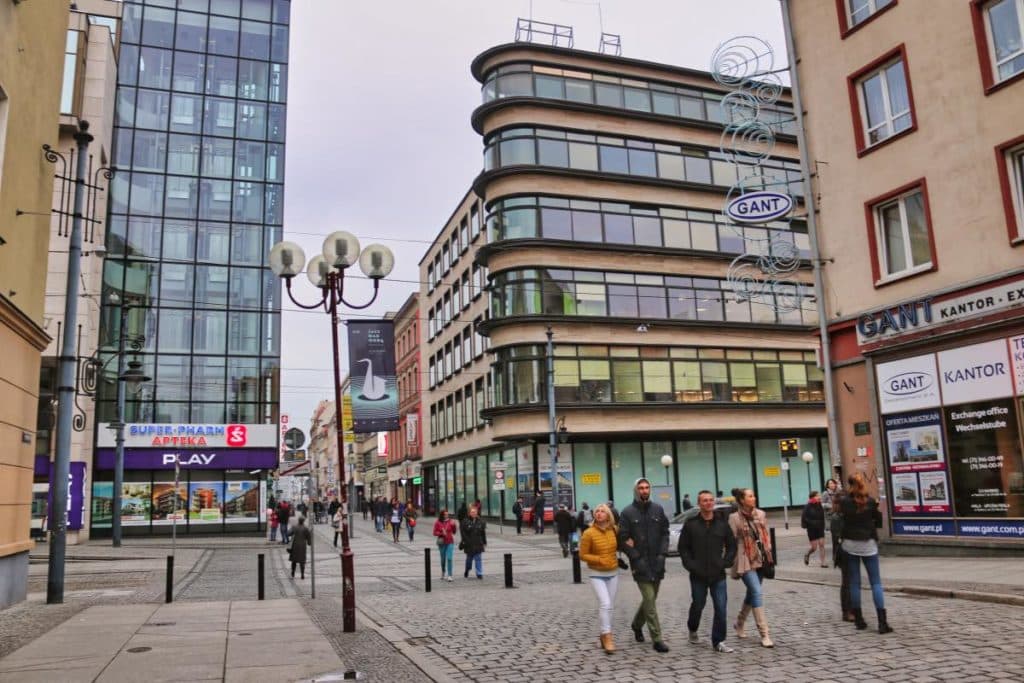
Department Store Rudolf Petersdorff
There are also many Art Nouveau houses and decorations in the city. A little later, department store architecture was added. The large department stores in Wroclaw, such as the Rudolf Petersdorff department store on Ulica Szewska, were mostly owned by Jewish families. They were expropriated by the Nazis in the course of the expulsion of the Jews. The department store was built by the famous architect Erich Mendelsohn, who also built the Schaubühne am Lehniner Platz in Berlin. The department store in Wroclaw stands with half a cylinder in the public space. I think it’s just beautifully designed.
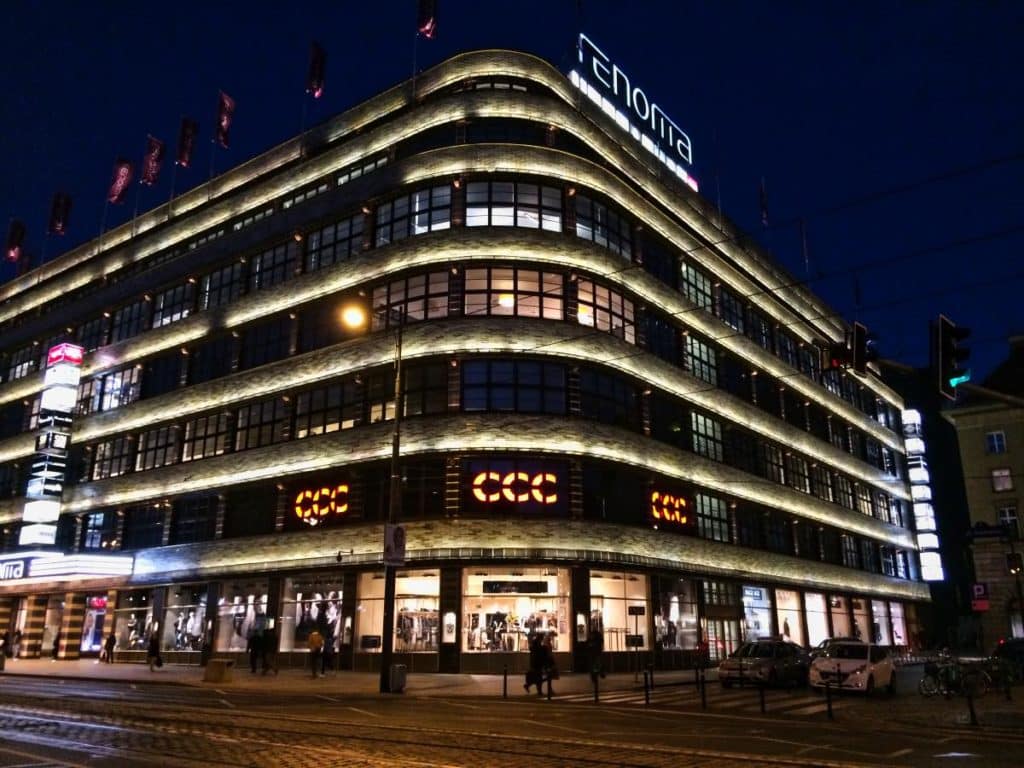
Wertheim Department Store – today Renoma
The former Wertheim department store is one of my favorite buildings in Wroclaw. Built between 1928 and 1930 according to plans by architect Hermann Dernburg, it was the city’s largest department store at the time. Completely burned out during the war, it was given its current name Renoma in the Polish People’s Republic. Since 2009, the department store is now a shopping center and attracts many visitors.
Turn of the Century Buildings
The Feniks department store (Rynek 31-32), the former department store of the Barasch brothers, should also not be overlooked. The Art Nouveau façade and the globe on the roof are reminiscent of Wroclaw’s glory days. You should also visit the Hotel Monopol (Ulica Świdnicka), where Marlene Dietrich and Pablo Picasso stayed.
Parks and gardens in Wrocław
Wroclaw is not only a very beautiful city, but also very green one. Riverside paths along the Odra River and many islands, as well as parks and gardens invite you to linger and relax from the noise of the busy city.
Szczytnicki Park
Szczytnicki Park, formerly Scheitniger Park, is the largest park in the city and is extremely spacious at over 100 hectares. It offers visitors all kinds of Wroclaw sights. The park was first laid out in 1785. However, the most important expansion came with Peter Joseph Lenné, who also designed the gardens and parks of the Prussian palaces, especially in Potsdam and Berlin. Another special feature is the wooden church of St. John Nepomuk, which was actually built by carpenters in Stary Koźle and only came to Wroclaw in 1913.
Japanese Garden Wroclaw
Right next to the Centennial Hall, the Japanese Garden was created between 1909 and 1912. It was also created for the Wroclaw Centennial Exhibition, but subsequently fell into disrepair. In the 1990s, the Japanese Embassy in Poland helped restore the park. The park is called Hakkoen, the Red and White Garden, which is a reference to the colors of the national flag that both countries share. Today there are again some Japanese style buildings to see here, so you will actually feel a bit like in Japan during your visit.
Zoo Wrocław und Afrykarium
Wroclaw Zoo is one of the most species-rich zoos in the world, with more than 1,100 species and over 10,000 animals, it is definitely the largest zoo in Poland. It was one of the first zoos in the German Reich to show animals in outdoor enclosures and not just in cages. The zoo was badly destroyed during the Second World War, but was reopened in 1947 and has been expanded ever since. Today, the so-called Afrykarium is particularly popular. In this oceanarium and enclosure, the Red Sea, hippos and large lakes, a shark tank, the Skeleton Coast in Namibia and the Congo Hall attract visitors.
Wroclaw sightseeing tours
To get a perfect overview of the sights of Wroclaw, you can easily organize a tour with a guide. We can recommend you the following tours.
- 3-hour city tour on history and culture*– Great overview of the city and the most important sights.
- Wroclaw Centennial Hall and surroundings*– Take a look at the Centennial Hall with an expert guide and learn interesting details that you would not find on your own.
- Culinary city tour*– the way to Wroclaw’s heart is through its stomach!
If this doesn’t appeal to you, take a look at the other offers for Wroclaw tours*.
Wroclaw tips and book
You can also find more information about Wroclaw in the Wroclaw-Guide, a monothematic blog for everything to do with this wonderful Polish city. Ewa and Mirko have also written their own book with lots of tips for the city. Highly recommended!
No products found.


